Current Research
Projects:
1. A General and Robust Strategy for Monodisperse Functional Nanocrystals (i.e., Plain, Core/Shell, Hollow and Janus Nanocrystals)
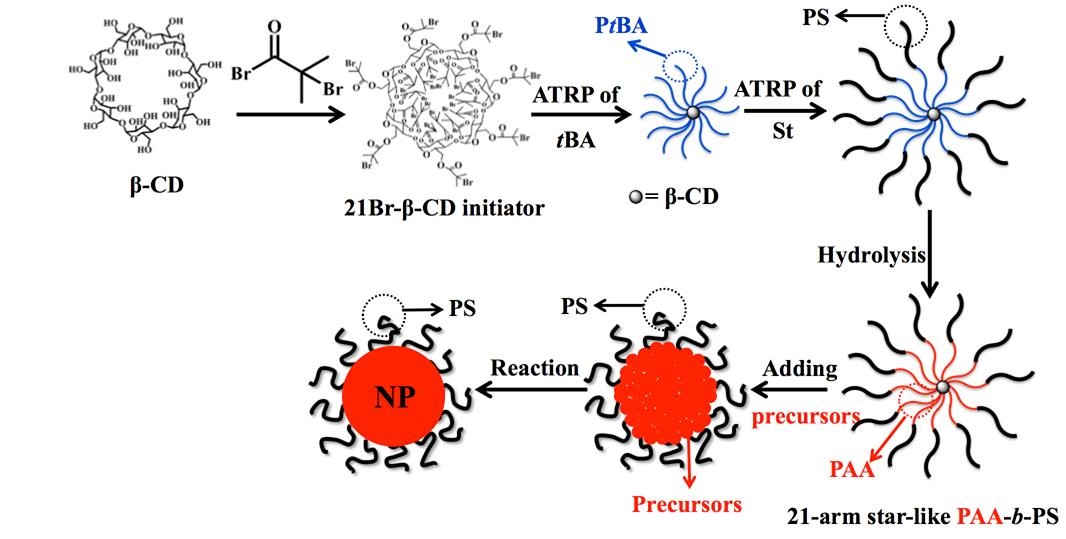
Colloidal nanocrystals exhibit a wide range of size- and shapedependent properties and have found application in myriad fields, incuding optics, electronics, mechanics, drug delivery and catalysis, to name but a few. Synthetic protocols that enable the simple and convenient production of colloidal nanocrystals with controlled size, shape and composition are therefore of key general importance. Current strategies include organic solution-phase synthesis, thermolysis of organometallic precursors, sol–gel processes, hydrothermal reactions and biomimetic and dendrimer templating. Often, however, these procedures require stringent experimental conditions, are difficult to generalize, or necessitate tedious multistep reactions and purification. Recently, linear amphiphilic block co-polymer micelles have been used as templates to synthesize functional nanocrystals, but the thermodynamic instability of these micelles limits the scope of this approach. We have been developing a general strategy for crafting a large variety of functional nanocrystals with precisely controlled dimensions, compositions and architectures by using star-like block copolymers as nanoreactors. This new class of co-polymers forms unimolecular micelles that are structurally stable, therefore overcoming the intrinsic instability of linear block co-polymer micelles. Our approach enables the facile synthesis of organic solvent- and water-soluble nearly monodisperse nanocrystals with desired composition and architecture, including core–shell and hollow nanostructures. We demonstrate the generality of our approach by describing, as examples, the synthesis of various sizes and architectures of metallic, ferroelectric, magnetic, semiconductor and luminescent colloidal nanocrystals.
Representative Publications:
12. Y. Liu, J. Wang, M. Zhang, H. Li, and Z. Lin, "Polymer-Ligated Nanocrystals Enabled by Non-Linear Block Copolymer Nanoreactors: Synthesis, Properties and Applications”, ACS Nano.14, 12491 (2020).
11. Y. He, Y. J. Yoon, Y. W. Harn, G. V. Biesold-McGee, S. Liang, C. H. Lin, V. V. Tsukruk, N. Thadhani, Z. Kang, and Z. Lin, "Unconventional Route to Dual-Shelled Organolead Halide Perovskite Nanocrystals with Controlled Dimensions, Surface Chemistry and Stabilities”, Science Advances 5, eaax4424 (2019).
10. Y. Chen, Z. Wang, Y. W. Harn, S. Pan, Z. Li, S. Lin, J. Peng, G. Zhang, and Z. Lin, "Resolving Optical and Catalytic Activities in Thermoresponsive Nanoparticles by Permanent Ligation with Temperature-Sensitive Polymers”, Angewandte Chemie International Edition. 58, 11910 (2019).
9. Y. Chen, Z. Wang, Y. He, Y. J. Yoon, J. Jung, G. Zhang, and Z. Lin, "Light-Enabled Reversible Self-Assembly and Tunable Optical Properties of Stable Hairy Nanoparticles”, Proceedings of the National Academy of Sciences of the United State of America. 115, E1391 (2018).
8. Y. Chen, D. Yang, Y. J. Yoon, X. Pang, Z. Wang, J. Jung, Y. He, Y. W. Harn, M. He, S. Zhang, G. Zhang, and Z. Lin, "Hairy Uniform Permanently-Ligated Hollow Nanoparticles with Precise Dimension Control and Tunable Optical Properties”, Journal of the American Chemical Society. 139, 12956 (2017).
7. Y. He, X. Pang, B. Jiang, C. Feng, Y. Harn, Y. Chen, Y. Yoon, S. Pan, C.-H. Lu, Y.Chang, M. Zebarjadi, Z. Kang, N. Thadhani, J. Peng, and Z. Lin, "Unconventional route to uniform hollow semiconducting nanoparticles with tailorable dimensions, compositions, surface chemistry and near-infrared absorption”, Angewandte Chemie International Edition. 56, 12946 (2017).
6. X. Pang, Y. He, J. Jung, and Z. Lin, "1D Nanocrystals with Precisely Controlled Dimension, Composition and Architecture”, Science. 353, 1268 (2016).
5. B. Jiang, X. Pang, B. Li, and Z. Lin, "Organic-inorganic nanocomposites via placing monodisperse ferroelectric nanocrystals in direct and permanent connect with ferroelectric polymers”, Journal of the American Chemical Society. 137, 11760 (2015).
4. D. Yang, X. Pang, Y. He, Y. Wang, G. Chen, W. Wang, and Z. Lin, "Precisely Size-Tunable Magnetic/Plasmonic Core/Shell Nanoparticles with Controlled Optical Properties”, Angewandte Chemie International Edition . 54, 12091 (2015).
3. H. Xu, X. Pang, Y. He, M. He, J. Jung, H. Xia, and Z. Lin, "An Unconventional Route to Monodisperse and Intimate Semiconducting Organic-Inorganic Nanocomposites”, Angewandte Chemie International Edition. 54, 4636 (2015).
2. H. Xu, Y. Xu, X. Pang, Y. He, J. Jung, H. Xia, and Z. Lin, "A general route to nanocrystal kebabs periodically assembled on stretched flexible polymer shish”, Science Advances. 1, e1500025 (2015).
1. X. Pang, L. Zhao, W. Han, X. Xin, and Z. Lin, "A general and robust strategy for the synthesis of nearly monodisperse colloidal nanocrystals”, Nature Nanotechnology, 8, 426 (2013).
2. Materials for Solar Energy Conversion
![]() Perovskite Solar Cells
Perovskite Solar Cells
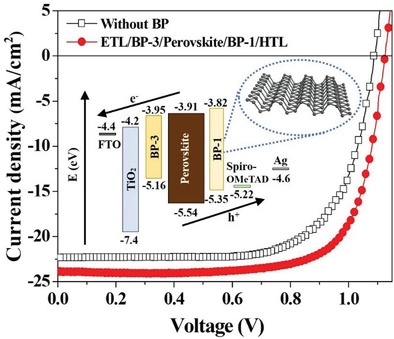
Perovskite is named after Russian mineralogist Perovskite who first characterized the crystal structure of ABX3-type (X=halogen, oxygen; e.g., CaTiO3) inorganics. The superior optoelectronic properties of organometal halide perovskite CH3NH3PbX3 (X=halogen) such as high absorption coefficient, long-distance exciton diffusion, and large charge carrier mobility shed new light on fabricating high-performance, low-cost, and stable solar cells. In this project, we focus on developing new perovskite photovoltaic materials, engineering device architectures of perovskite-based solar cells, and exploring photophycial mechanisms of perovskite-based solar cells, thereby leading to high-efficiency solar cells.
Representative Publications:
10. B. Wang, M. Zhang, X. Cui, Z. Wang, M. Rager, Y. Yang, Z. Zou, Z. L. Wang, and Z. Lin, "Unconventional Route to Oxygen Vacancies-Enabled Highly Efficient Electron Extraction and Transport in Perovskite Solar Cells”, Angewandte Chemie International Edition 59, 1661 (2020).
9. M. Zhang, M. Ye, W. Wang, C. Ma, S. Wang, Q. Liu, T. Lian, J. Huang, and Z. Lin, "Synergistic Cascade Carrier Extraction via Dual Interfacial Positioning of Ambipolar Black Phosphorene for High-Efficiency Perovskite Solar Cells”, Advanced Materials. 32, 2000999 (2020).
8. J. Qi, S. Chen, C. Lan, A. C. Wang, X. Cui, Z. You, Q. Zhang, Y. Li, Z. L. Wang, H. Wang, and Z. Lin, "Large-Grained Perovskite Films Enabled by One-Step Meniscus-Assisted Solution Printing of Cross-Aligned Conductive Nanowires for Biodegradable Flexible Solar Cells”, Advanced Energy Materials. 10, 2001185 (2020).
7. X. Cui, Y. Chen, M. Zhang, Y. W. Harn, J. Qi, L. Gao, Z. L. Wang, J. Huang, Y. Yang, and Z. Lin, "Tailoring Carrier Dynamics in Perovskite Solar Cells via Precise Di-mension and Architecture Control and Interfacial Positioning of Plasmonic Nanoparticles”, Energy & Environmental Science. 13, 1743 (2020).
6. M. Zhang, X. Cui, Y. Wang, W. Wang, C. Ma and Z. Lin, "Simple Route to Interconnected, Hierarchically Structured, Porous Zn2SnO4 Nanospheres as Electron Transport Layer for Efficient Perovskite Solar Cells”, Nano Energy, 71, 104620 (2020).
5. B. Wang, J. Iocozzia, M. Zhang, M. Ye, S. Yan, H. Jin, S. Wang, Z. Zou, and Z. Lin, "The Charge Carrier Dynamics, Efficiency and Stability of Two-Dimensional Material-Based Perovskite Solar Cells”, Chemical Society Reviews 48, 4854 (2019).
4. X. Meng, X. Cui, M. Rager, S. Zhang, Z. Wang, J. Yu, Y. Harn, Z. Kang, B. K. Wagner, Y. Liu, C. Yu, J. Qiu, and Z. Lin, "Cascade charge transfer enabled by incorporating edge-enriched graphene nanoribbons for mesostructured perovskite solar cells with enhanced performance”, Nano Energy. 52, 123 (2018).
3. M. He, B. Li, X. Cui, B. Jiang, Y. He, Y. Chen, D. O’Neil, P. Szymanski, M. A. EI-Sayed, J. Huang, and Z. Lin, "Meniscus-Assisted Solution Printing of Large-Grained Perovskite Films for High-Efficiency Solar Cells”, Nature Communications. 8, 16045 (2017).
2. M. He, X. Pang, X. Liu, B. Jiang, Y. He, H. Snaith, and Z. Lin, "Monodisperse Dual-Functional Upconversion Nanoparticles-Enabled Near-Infrared Organolead Halide Perovskite Solar Cells”, Angewandte Chemie International Edition. 55, 4280 (2016).
1. M. He, D. Zheng, M. Wang, C. Lin, and Z. Lin, "High efficiency perovskite solar cells: from complex nanostructure to planar heterojunction”, Journal of Materials Chemistry A, 2, 5994 (2014).(Invited Feature Article)
![]() Perovskite Photodetectors
Perovskite Photodetectors

Representative Publications:
2. S. Pan, H. Zou, A. C. Wang, Z. Wang, J. Yu, C. Lan, Q. Liu, Z. Wang, T. Lian, J. Peng, and Z. Lin, "Rapid Capillary-Assisted Solution Printing of Perovskite Nanowire Arrays Enables Scalable Production of Photodetectors”, Angewandte Chemie International Edition 59, 14942 (2020)
1. C. Lan, H. Zou, L. Wang, M. Zhang, S. Pan, Y. Ma, Y. Qiu, Z. L. Wang, and Z. Lin, "Revealing Electrical-Poling-Induced Polarization Potential in Hybrid Perovskite Photodetectors”, Advanced Materials. (in press).
![]() Dye-Sensitized Solar Cells
Dye-Sensitized Solar Cells

Dye-sensitized solar cells (DSSC) are widely recognized as a promising alternative to conventional silicon solar cells, which usually suffer from a high cost of manufacturing and installation. A great deal of research efforts have been made in DSSCs to achieve improved performance, including the rational design and exploitation of a wide diversity of dyes as light absorbers, the optimization of nanocrystalline TiO2 photoanodes of different architectures for dye loading and electron transport, the utilization of redox electrolytes with effective components for hole transport, and the replacement of expensive noble metal films (e.g., platinum) with other low-cost materials to serve as back-contact electrodes. In this project, we capitalize on hierarchically structured nanotubes and nanoflowers as photoanodes to yield high efficiency DSSCs, which can be attributed primarily to the synergistic effect of higher dye loading due to the presence of large surface area, superior light scattering ability, and fast charge transport.
Representative Publications:
9. X. Meng, C. Yu, X. Song, J. Iocozzia, J. Hong, M. Rager, H. Jin, S. Wang, L. Huang, J. Qiu, and Z. Lin, "Scrutinizing Defects and Defect Density of Selenium-Doped Graphene for High-Efficiency Triiodide Reduction in Dye-Sensitized Solar Cell”, Angewandte Chemie International Edition. 57, 4682 (2018).
8. X. Meng, C. Yu, X. Zhang, L. Huang, M. Rager, J. Hong, J. Qiu, and Z. Lin, "Active sites-enriched carbon matrix enables efficient triiodide reduction in dye-sensitized solar cells: an understanding of the active centers”, Nano Energy. 54, 138 (2018).
7. M. Ye, X. Wen, M. Wang, J. Iocozzia, N. Zhang, C. Lin, and Z. Lin, "Recent advances in dye-sensitized solar cells: from photoanodes, sensitizers, electrolytes to counter electrodes”, Materials Today. 18, 155 (2015).
6. M. Ye, D. Zheng, M. Lv, C. Chen, C. Lin, and Z. Lin, "Hierarchically structured nanotubes for highly efficient dye-sensitized solar cells”, Advanced Materials , 25, 3039 (2013).
5. M. Ye, H. Liu, C. Lin, and Z. Lin, “Hierarchical rutile TiO2 flower clusters based high efficiency dye-sensitized solar cells via direct hydrothermal growth on conducting substrates”, Small, 9, 312 (2013).
4. Y. H. Jang, X. Xin, M. Byun, Y. Jang, Z. Lin, and D. H. Kim, “An unconventional route to high efficiency dye-sensitized solar cells via embedding graphitic thin films into TiO2 nanoparticle photoanode”, Nano Lett., 12, 479 (2012).
3. M. Ye, X. Xin, C. Lin, and Z. Lin, "High efficiency dye-sensitized solar cells based on hierarchically structured nanotubes”, Nano Lett., 11, 3214 (2011).
2. J. Wang and Z. Lin, "Dye sensitized TiO2 nanotube solar cell with markedly enhanced performance via rational surface engineering", Chem. Mater., 22, 579 (2010).
1. J. Wang and Z. Lin, "Freestanding TiO2 nanotube arrays with ultrahigh aspect ratio via electrochemical anodization", Chem. Mater., 20, 1257 (2008).
![]() Organic-Inorganic Nanocomposites by Placing Conjugated Polymers in Intimate Contact with Quantum Dots (Rods) and Their Use in Hybrid Solar Cells
Organic-Inorganic Nanocomposites by Placing Conjugated Polymers in Intimate Contact with Quantum Dots (Rods) and Their Use in Hybrid Solar Cells
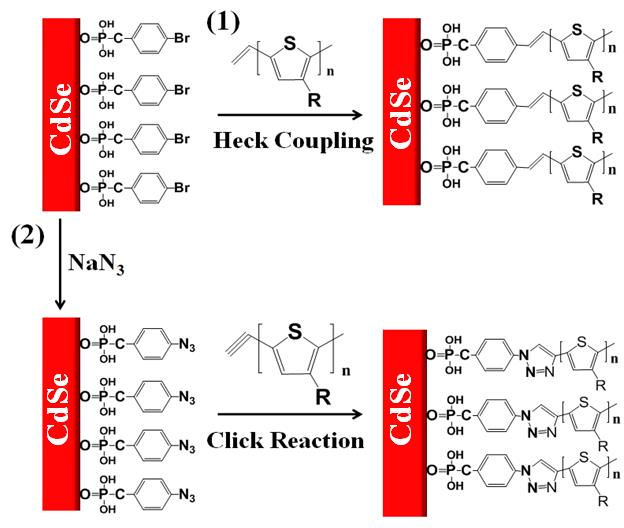
Placing conjugated polymers (CPs) in direct contact with quantum dots (QDs) (or quantum rods; QRs) offers advantages over cases where QD (QR) aggregation dominates. Such quantum dot (rod)-conjugated polymer nanocomposites (i.e., CP-QD (QR)) possess a well-defined interface, thereby significantly promoting the charge (or energy) transfer between these two components. In this project, we craft CP-QD (QR) nanocomposites based on rational designs, explore their photophysical properties, and exploit these intimate organic-inorganic nanocomposites for use in organic-inorganic hybrid solar cells with improved power conversion efficiency.
Representative Publications:
5. M. He, F. Qiu, and Z. Lin, "Towards high performance organic-inorganic hybrid solar cells: bringing conjugated polymers and inorganic nanocrystals in close contact”, The Journal of Physical Chemistry Letters, 4, 1788 (2013).
4. L. Zhao and Z. Lin, “Crafting semiconductor organic-inorganic nanocomposites via placing conjugated polymers in intimate contact with nanocrystals for hybrid solar cells”, Advanced Materials, 24, 4353 (2012). (Invited Review)
3. L. Zhao, X. Pang, R. Adhikary, J. Petrich, M. Jeffries-EL, and Z. Lin, "Organic-inorganic nanocomposites by placing conjugated polymers in intimate contact with quantum rods”, Advanced Materials, 23, 2844 (2011).
2. L. Zhao, X. Pang, R. Adhikary, J. Petrich, and Z. Lin, "Semiconductor anisotropic nanocomposites via directly coupling conjugated polymers with quantum rods”, Angewandte Chemie International Edition, 50, 3958 (2011).
1. J. Xu, J. Wang, M. Mitchell, P. Mukherjee, M. Jeffries-EL, J. W. Petrich, and Z. Lin, "Organic-inorganic nanocomposites prepared by grafting conjugated polymers onto quantum dots", Journal of the American Chemical Society, 129, 12828 (2007).
![]() Quantum Dot-Sensitized Solar Cells
Quantum Dot-Sensitized Solar Cells
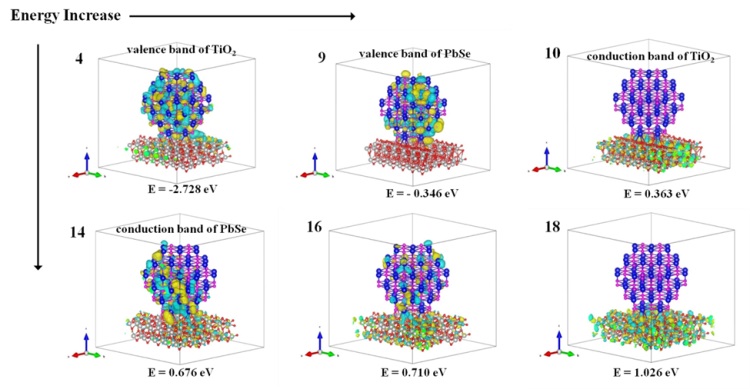
Quantum dot-sensitized solar cells (QDSSCs) have emerged as a promising solar architecture for next-generation solar cells. The QDSSCs exhibit a remarkably fast electron transfer from the quantum dot (QD) donor to the TiO2 acceptor with size quantization properties of QDs that allows for the modulation of band energies to control photoresponse and photoconversion efficiency of solar cells. To understand the mechanisms that underpin this rapid charge transfer, the electronic properties of CdSe and PbSe QDs with different sizes on the TiO2 substrate are simulated using a rigorous ab initio density functional method. This method capitalizes on localized orbital basis set, which is computationally less intensive. Quite intriguingly, a remarkable set of electron bridging states between QDs and TiO 2 occurring via the strong bonding between the conduction bands of QDs and TiO2 is revealed. Such bridging states account for the fast adiabatic charge transfer from the QD donor to the TiO2 acceptor, and may be a general feature for strongly coupled donor/acceptor systems. All the QDs/TiO2 systems exhibit type II band alignments, with conduction band offsets that increase with the decrease in QD size. This facilitates the charge transfer from QDs donors to TiO2 acceptors and explains the dependence of the increased charge transfer rate with the decreased QD size.
Representative Publications:
1. X. Xin, R. Biswas, B. Li, J. Jung, Y. Yoon, and Z. Lin, "Ab initio simulation of charge transfer at the semiconductor quantum dot/TiO2 interface in quantum dot-sensitized solar cells”, Particle and Particle Systems Characterization, 32, 80 (2015).
![]() Polymer Solar Cells
Polymer Solar Cells

The synthesis and self-assembly of rod-rod diblock copolymers that possess both intriguing nanostructures and electronic activities provide expanded opportunities for developing high-performance bulk heterojunction (BHJ) solar cells. In this project, we explore the molecular organization of a new class of all-conjugated diblock copolymers, poly(3-butylthiophene)-b-poly(3-hexylthiophene) (P3BHT) chains (i.e., the packing of interchains) and the nanoscale morphology of the resulting P3BHT/PC71BM thin blend films, which can be precisely controlled by tailoring the molar ratio of P3BT and P3HT blocks in P3BHT, thereby leading to solar cells with improved performance.
Representative Publications:
3. M. He, F. Qiu, and Z. Lin,"Conjugated rod-coil and rod-rod block copolymers for photovoltaic applications”, Journal of Materials Chemistry, 21, 17039 (2011). (Invited Feature Article) .
2. M. He, W. Han, J. Ge, Y. L. Yang, F. Qiu, and Z. Lin, "High efficiency all-conjugated poly(3-alkylthiophene) diblock copolymer-based bulk heterojunction solar cells with controlled molecular organization and nanoscale morphology", Energy Environ. Sci., 4, 2894 (2011).
1. M. He, L. Zhao, J. Wang, W. Han, Y. L. Yang, F. Qiu, and Z. Lin, "Self-assembly of all-conjugated poly(3-alkylthiophene) diblock copolymer nanostructures from mixed selective solvents", ACS Nano, 4, 3241 (2010).
3. Materials for Light Emitting Diodes (LEDs) (Perovskite LEDs)
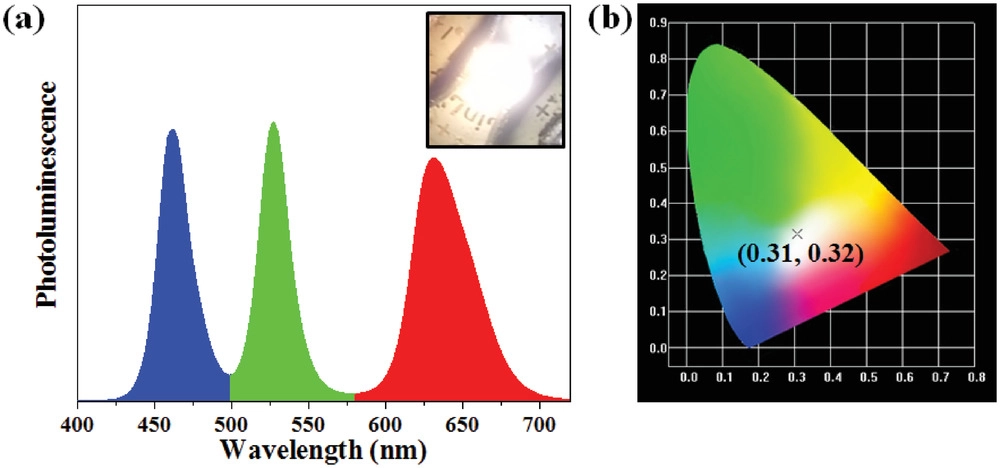
Representative Publications:
5. C. H. Lu, G. Biesold-McGee, Y. Liu, Z. Kang, and Z. Lin, "Doping and Ion Substitution in Colloidal Metal Halide Perovskite Nanocrystals”, Chemical Society Reviews. 49, 4953 (2020).
4.S. Pan, Y. Chen, Z. Wang, Y. Harn, J. Yu, A. Wang, M. J. Smith, Z. Li, V. V. Tsukruk, J. Peng, and Z. Lin, "Strongly-ligated Hollow Perovskite Quantum Dots with Precisely Controlled Dimensions and Architectures for Wide Light-Emitting Diodes”, Nano Energy, 77, 105043 (2020).
3. Y. J. Yoon, Y. Chang, S. Zhang, S. Pan, Y. He, C. Lin, S. Yu, Y. Chen, Z. Wang, J. Jung, N. Thadhani, V. Tsukruk, Z. Kang, and Z. Lin, "Enabling Tailorable Optical Properties and Markedly Enhanced Stability of Perovskite Quantum Dots by Permanently Ligating with Polymer Hairs”, Advanced Materials. 31, 1901602 (2019).
2. Y. Liu, Z. Wang, S. Liang, Z. Li, M. Zhang, H. Li, Z. Lin, "Stable Perovskite Nanocrystals Permanently Ligated with Polymer Hairs via Star-like Molecular Bottlebrush Trilobe Nanoreactors”, Nano Letters 19, 9019 (2019).
1. Y. Chang, Y. Yoon, G. Li, E. Xu, S. Yu, C. Lu, Z. Wang, Y. He, C. Lin, B. K. Wagner, V. V. Tsukruk, Z. Kang, N. Thadhani, Y. Jiang, and Z. Lin, "All-Inorganic Perovskite Nanocrystals with a Stellar Set of Stabilities and Their Use in White Light-Emitting Diodes”, ACS Applied Materials & Interfaces. 10, 37267 (2018).
4. Materials for Energy Storage (Li-ion, Na-ion, and Zn-Air Batteries)
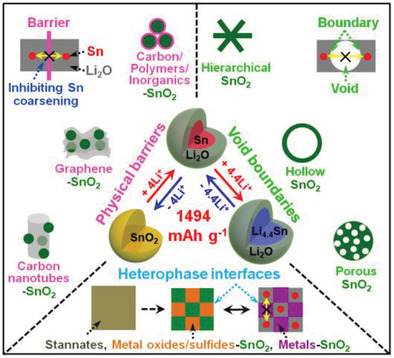
Nowadays, industrial and transportation activities consume a large amount of fossil fuels. The imminent shortage of fossil fuels and growing environmental concern are pushing scientists and engineers to exploit sustainable, clean, and highly efficient technologies to supply and store energy. Lithium ion batteries (LIBs) have dominated the battery market for decades, however, unsatisfactory energy and power densities restrict the application of LIBs in portable devices, electric vehicles, and grid-scale energy storage. In this project, we focus on the design and fabrication of nanostructured electrode materials for high performance LIBs, as well as a series of novel batteries including lithium-metal, lithium-sulfur, sodium-ion, zinc-ion, and zinc-air batteries. A set of electrode materials have been constructed and investigated, such as Zn2GeO4, CuGeO3, ZnFe2O4, SnO2, TiO2, Fe2O3, MnO2, Co3O4, etc. Additionally, to further tackle the inflammability of liquid organic electrolytes and volatility of aqueous electrolytes, solid-state electrolytes have also been studied for the construction of flexible batteries.
Representative Publications:
7.S. Zhao, C. D. Sewell, R. Liu, S. Jia, X. Liu, Z. Wang, Y. He, K. Yuan, H. Jin, S. Wang, and Z. Lin, "SnO2 as advanced anode of lithium-ion batteries: inhibiting Sn coarsening by crafting robust physical barriers, grain boundaries and heterophase interfaces for superior electrochemical reaction reversibility”, Advanced Energy Materials. 10, 1902657 (2020).
6. S. Zhao, Z. Wang, Y. He, H. Jiang, Y. W. Harn, X. Liu, C. Su, H. Jin, Y. Li, S. Wang, Q. Shen, and Z. Lin, "A Robust Route to Co2(OH)2CO3 Ultrathin Nanosheets with Superior Lithium Storage Capability Templated by Aspartic Acid-Functionalized Graphene Oxide”, Advanced Energy Materials. 9, 1901093 (2019).
5. S. Jia, Y. Wang, X. Liu, S. Zhao, W. Zhao, Y. Huang, Z. Li, and Z. Lin, "Hierarchically Porous CuO Nano-labyrinths as Binder-free Anodes for Long-Life and High-Rate Lithium Ion Batteries”, Nano Energy. 59, 229 (2019).
4. B. Jiang, Y. He, B. Li, S. Zhao, S. Wang, Y. He, and Z. Lin, "Polymer-Templated Formation of Polydopamine-Coated SnO2 Nanocrystals: Anodes for Cyclable Lithium-Ion Batteries”, Angewandte Chemie International Edition. 56, 1869 (2017).
3. S. Zhao, Z. Wang, Y. He, B. Jiang, Y. Harn, X. Liu, F. Yu, F. Feng, Q. Shen, and Z. Lin, "Interconnected Ni(HCO3)2 Hollow Spheres Enabled by Self-Sacrificial Templating with Enhanced Lithium Storage Properties”, ACS Energy Letters. 2, 111 (2017).
2. B. Jiang, C. Han, B. Li, Y. He, and Z. Lin, "In-situ Crafting of ZnFe2O4 Nanoparticles Impregnated within Continuous Carbon Network as Advanced Anode Materials”, ACS Nano. 10, 2728 (2016).
1. S. Wu, R. Xu, M. Lu, R. Ge, J. Iocozzia, C. Han, B. Jiang, and Z. Lin, "Graphene-Containing Nanomaterials for Lithium Ion Battery”, Advanced Energy Materials. 5, 1500400 (2015).
5. Materials for Photocatalysis and Electrocatalysis
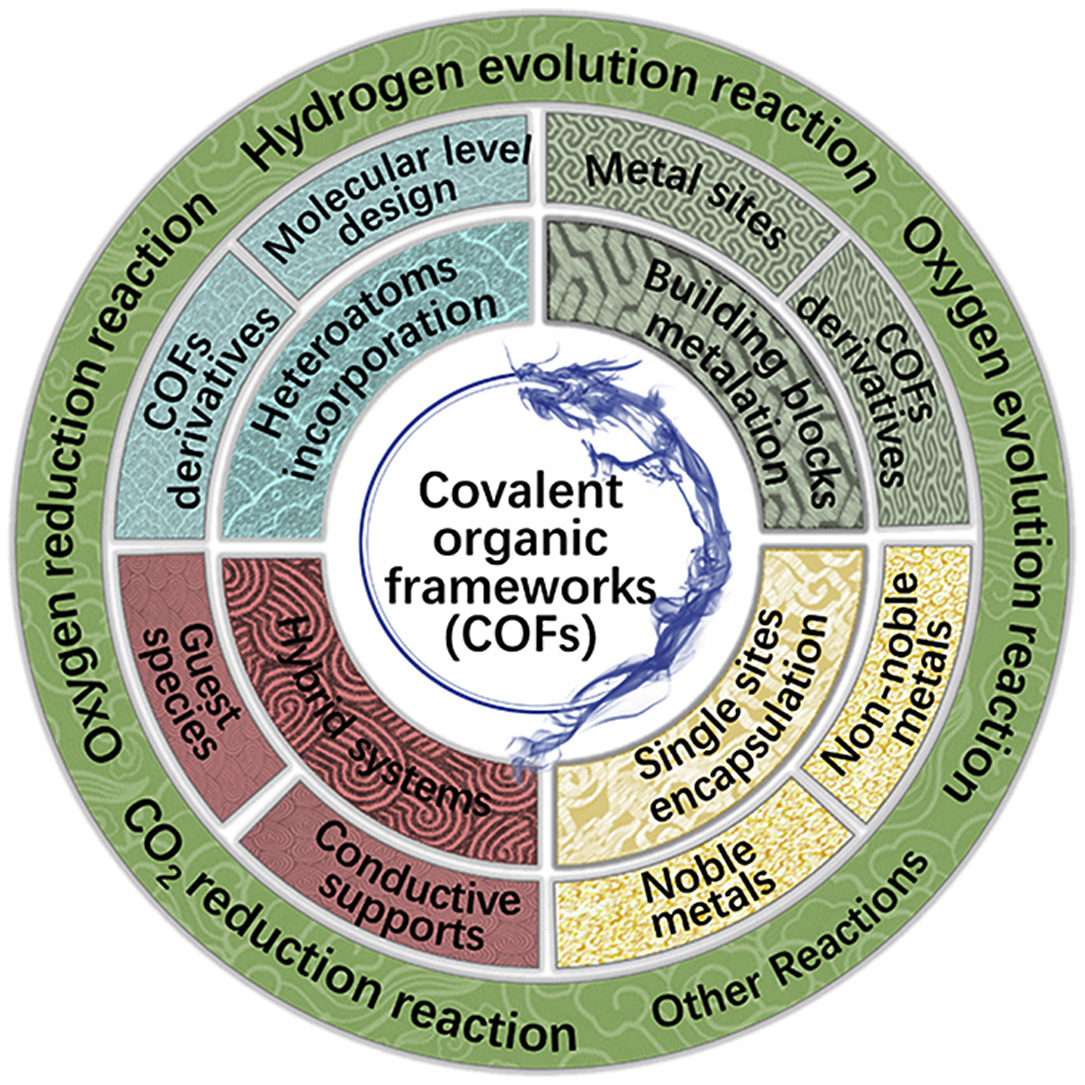
Environmental issues induced by continuing consumption of non-renewable fossil fuels are becoming more prominent, and developing sustainable and efficient energy conversion devices represents a new fashion to mitigate these issues. The past several years has witnessed explosive developments in energy conversion and storage reactions such as oxygen reduction reaction (ORR) and water splitting reactions, which could be part of the process to store electrical energy generated from renewable resources and photon energy from light (UV, visible light and infrared light a near-infrared light)in a chemical fuel. In this project, aiming at improving the efficiency of those energy conversion related reactions, efficient photocatalysts and electrocatalysts such as single atoms sites catalysts, monodispersed nanoparticles, nanorods, Janus nanoparticles and etc. will be designed to accelerate the low kinetics of those reactions.
Representative Publications:
7. M. Zhang, X. Xuan, W. Wang, C. Ma, and Z. Lin, "Anode photovoltage compensation-enabled synergistic CO2 photoelectrocatalytic reduction on a flower-like graphene-decorated Cu foam cathode”, Advanced Functional Materials. (in press).
6. X. Cui, S. Lei, A. C. Wang Y. L. Gao, Q. Zhang, Y. Yang, and Z. Lin, "Emerging Covalent Organic Frameworks Tailored Materials for Electrocatalysis”, Nano Energy, 70, 104525 (2020).
5. M. Wang, B. Wang, F. Huang, and Z. Lin, "Enabling PIEZOpotential in PIEZOelectric Semiconductors for Enhanced Catalytic Activities”, Angewandte Chemie International Edition. 58, 7526 (2019).
4. M. Wang, D. Zheng, M, Ye, X. Xu, C. Lin, L. Sun, and Z. Lin, "One-dimensional densely aligned perovskite-decorated semiconductor heterojunctions with enhanced photocatalytic activity”, Small. 11, 1436 (2015).
3. M. Wang, J. Ioccozia, L. Sun, C. Lin, and Z. Lin, "Inorganic-modified semiconductor TiO2 nanotube arrays for photocatalysis”, Energy & Environmental Science , 7, 2182 (2014).(Invited Review Article)
2. M. Wang, L. Sun, Z. Lin, J. Cai, K. Xie, and C. Lin, "p-n heterojunction photoelectrodes composed of Cu2O-loaded TiO2 nanotube arrays with enhanced photoelectrochemical and photoelectrocatalytic activities”, Energy & Environmental Science, 6, 1211 (2013).
1. M. Ye, J. Gong, Y. Lai, C. Lin, and Z. Lin, “High efficiency photoelectrocatalytic hydrogen generation enabled by palladium quantum dots sensitized TiO2 nanotube arrays”, Journal of the American Chemical Society, 134, 15720 (2012).
6. Materials for Thermoelectrics
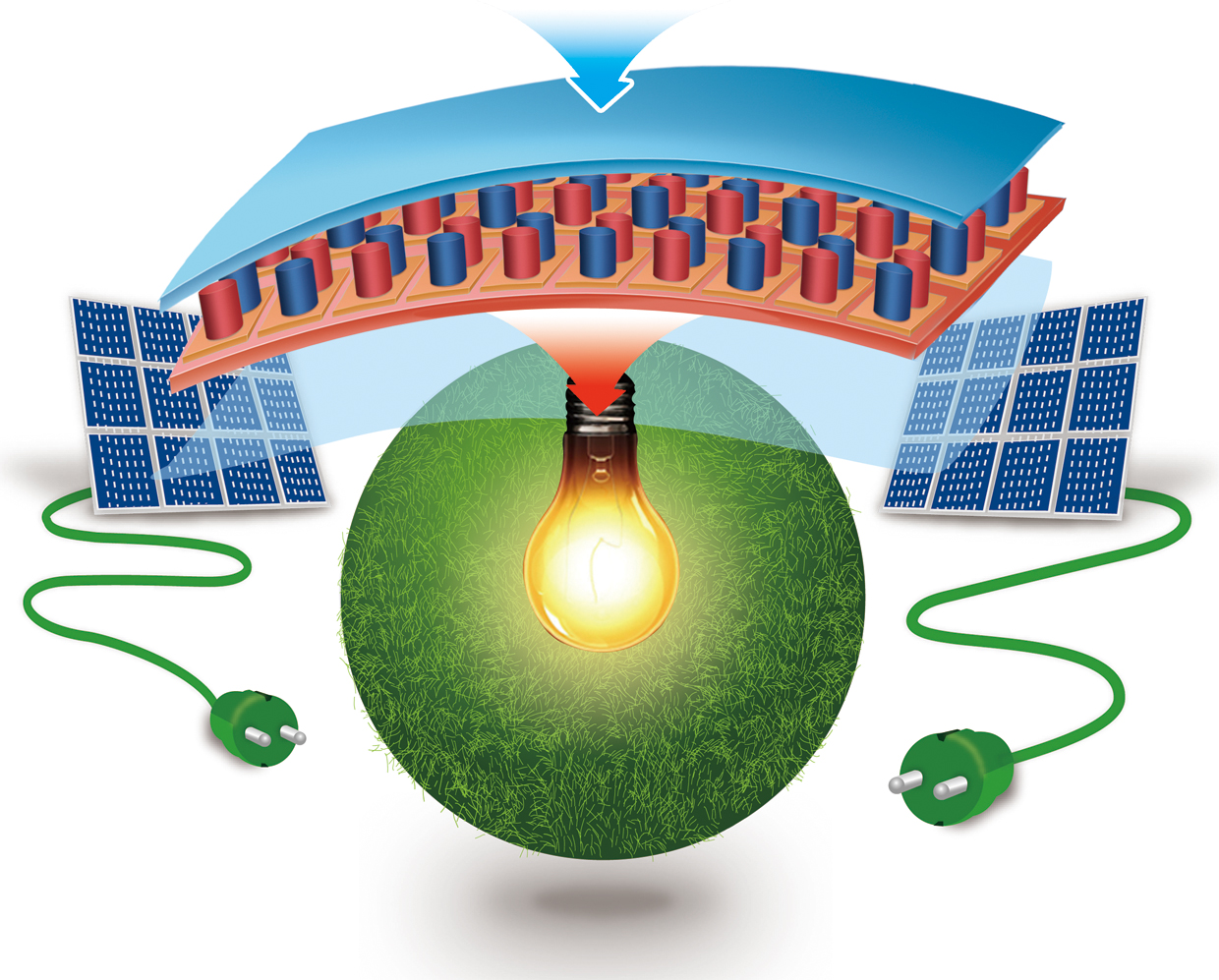
Thermoelectric materials have garnered considerable attention due to their unique ability to directly convert heat to electricity and vice versa. Polymers carry many intrinsic advantages such as low thermal conductivity, solution processability, and roll-to-roll production for fabricating high-performance, lightweight, and flexible thermoelectric modules. In this project, we have been working on the preparation, modification and optimization of polymer-based thermoelectric materials, focusing especially on the facile strategies to minimize the thermal conductivity and maximize the power factor.
Representative Publications:
3. Z. Lin,and M. He, "Organic Thermoelectric Materials (ISSN)", 1st Edition, Royal Society of Chemistry ,Cambridge, UK (2019)
2. H. Xu, X. Pang, Y. He, M. He, J. Jung, H. Xia, and Z. Lin, "An Unconventional Route to Monodisperse and Intimate Semiconducting Organic-Inorganic Nanocomposites”, Angewandte Chemie International Edition. 54, 4636 (2015).
1. M. He, F. Qiu, and Z. Lin, "Towards high-performance polymer-based thermoelectric materials”, Energy & Environmental Science, 6, 1352 (2013).
7. Learning from “Coffee Ring”: Ordered Structures Composed of Polymers and Nanocrystals Crafted by Evaporative Self-Assembly
![]() Controlled Evaporative Self-Assembly (CESA)
Controlled Evaporative Self-Assembly (CESA)
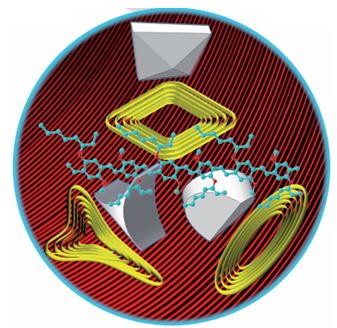
Drying of solutions has been the subject of increasingly active research aimed at better understanding the physics of evaporation process and capitalizing on its extreme simplicity to assemble a wide diversity of nonvolatile solutes into a multitude of complex ordered structures on the submicron length scale and beyond. In this project, we learn from very familiar “Coffee Ring” phenomena and develop simple yet robust preparation approaches that provide the capability of crafting structures with unprecedented regularity composed of polymers, nanoparticles, biomaterials, among others enabled by controlled evaporation-driven, flow-aided self-assembly in confined geometries. A broad range of important variables that can be brought into play to control deposition are investigated.
Representative Publications:
13. W. Han, M. He, M. Byun, B. Li, and Z. Lin, “Large-scale hierarchically structured conjugated polymer assemblies with enhanced electrical conductivity”, Angewandte Chemie International Edition, 52, 2564 (2013).
12. M. Byun, W. Han, B. Li, X. Xin, and Z. Lin, "An unconventional route to hierarchically ordered block copolymer on gradient patterned surface enabled by controlled evaporative self-assembly”, Angewandte Chemie International Edition, 52, 1122(2013).
11. W. Han, M. Byun, B. Li, X. Pang, and Z. Lin, "A simple route to hierarchically assembled micelles and inorganic nanoparticles”, Angewandte Chemie International Edition, 51, 12588 (2012).
10. W. Han and Z. Lin, “Learning from “coffee ring”: ordered structures enabled by controlled evaporative self-assembly”, Angewandte Chemie International Edition, 51,1534 (2012) (Invited Review).
9. M. Byun, W. Han, B. Li, S. Hong, J. Cho, Q. Zou, and Z. Lin, "Guided organization of λ-DNA into microring arrays from liquid capillary bridge”, Small,12, 1641 (2011).
8. M. Byun, N. B. Bowden, and Z. Lin, "Hierarchically organized structures engineered from controlled evaporative self-assembly",Nano Lett., 10,3111 (2010).
7. S. W. Hong, J. Wang, and Z. Lin, "Evolution of ordered block copolymer serpentines into a macroscopic, hierarchically ordered web", Angewandte Chemie International Edition, 48, 8356 (2009).
6. S. W. Hong, M. Byun, and Z. Lin, "Robust self-assembly of highly ordered complex structures by controlled evaporation of confined microfluids", Angewandte Chemie International Edition, 48, 512 (2009).
5. S.W. Hong, W. Jeong, H. Ko, M. Kessler, V.V. Tsukruk, and Z. Lin, "Directed self-assembly of gradient concentric carbon nanotube rings", Advanced Functional Materials,18, 2114 (2008).
4. J. Xu, J. Xia and Z. Lin, "Evaporation-induced self-assembly of nanoparticles from a sphere-on-flat geometry", Angewandte Chemie International Edition, 46, 1860 (2007).
3. S. W. Hong, J. Xia, and Z. Lin, "Spontaneous formation of mesoscale polymer patterns in an evaporating bound solution", Advanced Materials, 19, 1413 (2007).
2. S. W. Hong, J. Xu, and Z. Lin, "Template assisted formation of gradient concentric gold rings", Nano Letters, 6, 2949, (2006).
1. J. Xu, J. Xia, S. W. Hong, Z. Lin, F. Qiu and Y. Yang, "Self-assembly of gradient concentric rings via solvent evaporation from a capillary bridge", Physical Review Letters, 96, 066104 (2006).
![]() Flow-Enabled Self-Assembly (FESA)
Flow-Enabled Self-Assembly (FESA)
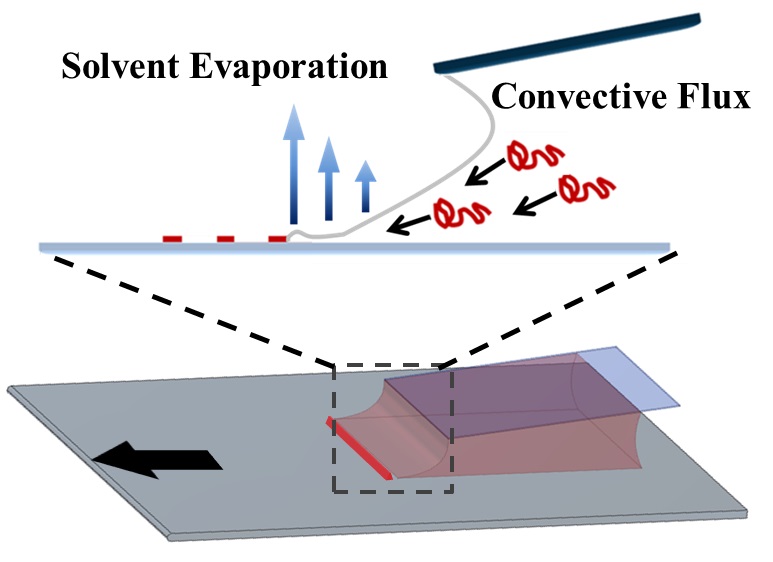
The goal of this project is to develop a simple yet robust flow-enabled self-assembly (FESA) method to reproducibly create highly ordered structures over large areas composed of functional nanocrystals and diblock copolymers in a precisely controllable manner that dispenses with the need for lithographic techniques. Three specific research objectives will be pursued: (1). Synthesize luminescent nanocrystals with precisely controllable size, shape, and surface characteristics. (2). Craft hierarchically ordered structures composed of nanocrystals over large areas via the synergy between flow-enabled self-assembly (FESA) at the microscopic scale and spontaneous self-assembly at the nanoscale. (3). Reveal the mechanism of structure formation via theoretical modeling. The ability to predict the length scales of periodicity and compare them with experimental observations will provide useful insight into ordered structure formation. We will also wisely design and tailor the periodicity, height, and width of highly ordered structures by precisely controlling the movement of the lower substrate in the FESA process.
Representative Publications:
4. B. Li, B. Jiang, W. Han, M. He, X. Li, W. Wang, S. Hong, M. Byun, S. Lin, and Z. Lin, "Harnessing Colloidal Crack via Flow-Enabled Self-Assembly”, Angewandte Chemie International Edition. 56, 4554 (2017).
3. B. Li, C. Zhang, B. Jiang, W. Han, and Z. Lin, "Flow-Enabled Self-Assembly of Large-Scale Aligned Nanowires”, Angewandte Chemie International Edition. 54, 4250 (2015).
2. B. Li, W. Han, B. Jiang, and Z. Lin, "Crafting threads of diblock copolymer micelles via flow-enabled self-assembly”, ACS Nano, 8, 2936 (2014).
1. B. Li, W. Han, M. Byun, L. Zhu, Q. Zou, and Z. Lin, "Macroscopic highly aligned DNA nanowires created by controlled evaporative self-assembly”, ACS Nano , 7, 4326 (2013).
![]() Probing Mechanical Properties in Gradient Polymer Patterns Enabled by Surface Instabilities
Probing Mechanical Properties in Gradient Polymer Patterns Enabled by Surface Instabilities
Description coming soon
8. Functional Nanocomposites
![]() All-Ferroelectric Organic-Inorganic Nanocomposites
All-Ferroelectric Organic-Inorganic Nanocomposites
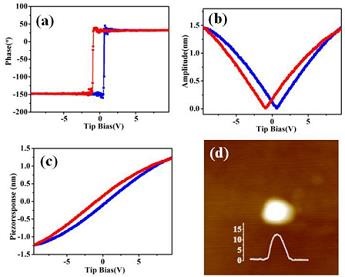
Description coming soon
Representative Publications:
2. B. Jiang, J. Iocozzia, L. Zhao, H. Zhang,Y.-W. Harn, Y. Chen, and Z. Lin, "Barium Titanate at the Nanoscale: Controlled Synthesis and Dielectric and Ferroelectric Properties”, Chemical Society Reviews. 48, 1194 (2019).
1. B. Jiang, X. Pang, B. Li, and Z. Lin, "Organic-inorganic nanocomposites via placing monodisperse ferroelectric nanocrystals in direct and permanent connect with ferroelectric polymers”, Journal of the American Chemical Society. 137, 11760 (2015).
![]() Multiferroic Nanocomposites
Multiferroic Nanocomposites
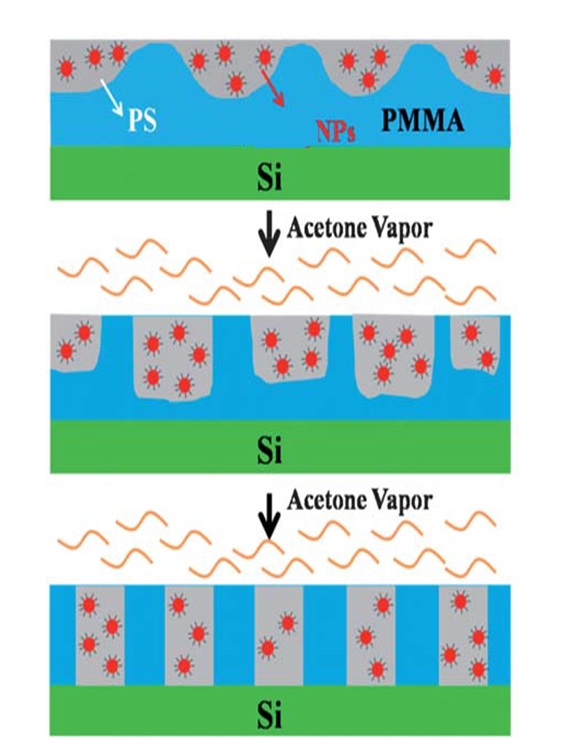
The use of block copolymers (BCPs) rather than a traditional homopolymer as the matrix offers unprecedented opportunities for controlling the spatial and orientational organization of nanoparticles in the nanocomposites by constraining the nanoparticles within desired block of copolymer. The magnetoelectric multiferroics are multifunctional materials that exhibit both magnetic order and electrical polarization in the same compound (i.e., ferromagnetic and ferroelectric). In these materials, the electric polarization can be induced by a magnetic field and conversely, and the magnetization can be induced by an electric field for use in spintronic devices, remote switchable devices, capacitors, sensors, magnetic data storage, etc. In this project, we intend to create novel nanocomposites, with long-range hierarchical order based on BCPs with nanoscopic multiferroic particles selectively incorporated into the target BCP domains may promise new opportunities for developing miniaturized multifunctional electromagnetic materials and devices with controlled dielectric permittivity and magnetic permeability.
9. Synthesis, Characterization and Self-Assembly of Nonlinear Functional Homopolymers and Block Copolymers via a Combination of Living Polymerizations (e.g., ATRP and RAFT) and Click Reaction
Star-like polymers have attracted considerable attention over the past decade due to their unique solution and solid-state properties. The main feature of star-shaped polymers, differing from the linear analogues of identical molar mass, is their compact structure (i.e., smaller hydrodynamic volume and radius of gyration) and high concentration of functional terminal groups, which enable them with higher solubility in common solvents, lower solution and melt viscosities, and modified thermal properties. Copolymer brushes composed of a flexible linear backbone and densely grafted side chains are a unique class of graft copolymers. Steric repulsion between polymeric side chains forces the backbone of copolymer brushes to adopt an extended chain conformation. In this project, we synthesize a large variety of non-linear polymers, including star-like homopolymers and block copolymers, bottle-brush copolymers, and macrocyclic brush copolymers, with well-defined molecular architectures, molecular weight, and ratio of two dissimilar blocks by sequential living polymerization (e.g., ATRPs) or by a combination of living polymerization with click reaction.
Representative Publications:
5.Y. Harn, Y. He, Z. Wang, Y. Chen, S. Liang, Z. Li, Q. Li, L. Zhu, and Z. Lin, "Synthesis of Amphiphilic and Double Hydrophilic Star-like Block Copolymers and the Dual pH-Responsiveness of Unimolecular Micelle" Macromolecules (in press).
4. C. Feng, X. Pang, Y. He, Y. Chen, G. Zhang, and Z. Lin, "A Versatile Strategy for Uniform Hybrid Nanoparticles and Nanocapsules”, Polymer Chemistry. 6, 5190 (2015).
3. X. Pang, L. Zhao, C. Feng, R. Wu, and Z. Lin, "Functional copolymer brushes composed of hydrophobic backbone and densely grafted conjugated side chains via a combination of click chemistry with living polymerization” Polymer Chemistry, 4, 2025 (2013)
2. X. Pang, L. Zhao, C. Feng, and Z. Lin, "Novel amphiphilic multi-arm, star-kike coil-rod diblock copolymers via a combination of click chemistry with living polymerization", Macromolecules, 44, 7176 (2011).
1. X. Pang, L. Zhao, M. Akinc, J. K. Kim, and Z. Lin, "Novel amphiphilic multi-arm, star-like block copolymers as unimolecular micelles”, Macromolecules, 44, 3746 (2011).
![]() Nanocapsules
Nanocapsules
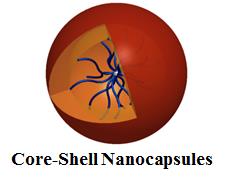
Unimolecular core-shell and hollow polymer nanoparticles with well-defined dimensions were crafted using spherical core-shell star-like diblock copolymers as templates. Monodisperse and structurally stable star-like diblock copolymers composed of inner degradable core blocks and outer photo-crosslinkable shell blocks were synthesized via a combination of two living polymerizations, namely, coordination-insertion ring opening polymerization (ROP) followed by reversible addition-fragmentation chain-transfer polymerization (RAFT). Subsequently, uniform unimolecular core-shell nanoparticles were successfully produced by photo-crosslinking the shell blocks of star-like diblock copolymers. The core diameter and shell thickness of nanoparticles are determined by molecular weights of inner core block and outer shell block, respectively, thereby rendering nanoparticles with tunable structural characteristics. The crosslinking density of nanoparticles can be readily controlled by varying the exposure time of star-like diblock copolymer templates to UV illumination. The selective degradation of inner core blocks yielded hollow polymer nanoparticles which retained structural integrity. The dye encapsulation and release studies revealed that unimolecular core-shell nanoparticles may be exploited as a new class of nanocarriers and promising drug nano-vehicles
Representative Publications:
1. C. Feng, X. Pang, Y. He, and Z. Lin, "A Robust Route to Unimolecular Core-shell and Hollow Polymer Nanoparticles” Chemistry of Materials. 26, 6058 (2014).
![]() Hyperbranched Polymers for Organic and Inorganic Nanoparticles
Hyperbranched Polymers for Organic and Inorganic Nanoparticles
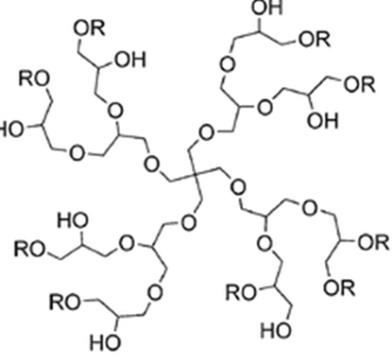
The development of reliable, generalizable and scalable nanoparticle synthesis techniques is an active area of research spanning several areas of engineering and science. Within this large group, various template-based techniques in which a nanoscopic scaffold is used to control the size, shape and composition are being investigated. This project focuses on one such technique relying on the ring opening multi-branching polymerization (ROMBP) of glycidol to produce hyperbranched polyglycerols (HPGs). Essential the star-like equivalent of linear poly( ethylene oxide) (PEO), HPG features a large number of exposed hydroxyl groups, is water soluble, biocompatible, and synthesizable in large quantities compared to other techniques. It is also useful as a polymerization initiator whose surface functionality can be controlled. This project focuses on synthesizing various star-like HPG copolymers to serve as templates for inorganic nanoparticles as well as organic nanoparticles outright.
Representative Publications:
2. J. Iocozzia and Z. Lin, "A clean and simple route to soft, biocompatible nanocapsules via UV-crosslinkable azido-hyperbranched polyglycerol”, Macromolecules. 50, 4906 (2017).
1. J. Iocozzia, and Z. Lin, "Solution-Stable Colloidal Gold Nanoparticles via Surfactant-free, Hyperbranched Polyglycerol-b-polystyrene Unimolecular Templates”, Langmuir . 32, 7180 (2016).
![]() Macrocyclic Rings
Macrocyclic Rings
Cyclic brush copolymers are of significant scientific interest due to its complex polymer architecture and unique properties. Synthesis of cyclic brush copolymers is challenging. Few studies on cyclic brush copolymers composed of PS/PEG as side chains were reported in the literature. However, cyclic brush copolymers grafted with conjugated polymers as side chains have never been investigated. In this project, a cyclic brush-like copolymer, poly(ethylene oxide)-g-poly(3-hexyl thiophene) (PEO-g-P3HT), composed of conjugated polymer P3HT as side chains was prepared by a combination of living anionic ring opening polymerization, quasi-living Grignard metathesis (GRIM) method and click chemistry. Due to its unique structure, its photovoltaic properties in solar cells is interesting and is currently being investigated.
10. Functional Nanomaterials
![]() Earch Abundent Environmentally Friendly Copper Zinc Tin Sulfide (Cu2ZnSnS4) Nanocrystals
Earch Abundent Environmentally Friendly Copper Zinc Tin Sulfide (Cu2ZnSnS4) Nanocrystals
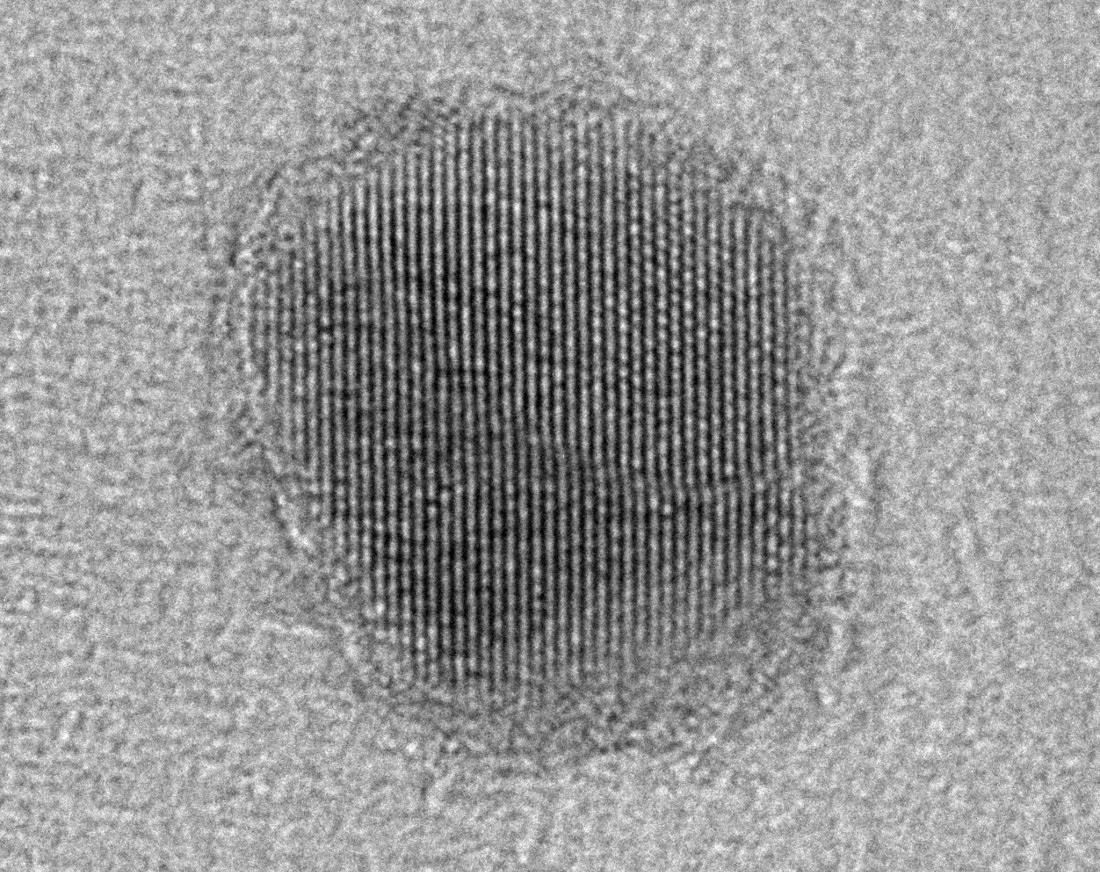
Achieving solar-to-electric energy conversion using inexpensive, abundantand nontoxic materials is an important goal. Solar cells based on thin films of semiconductors are emerging as inexpensive alternatives to silicon. However the two materials that yield the highest efficiency thin film solar cells, CdTe and Cu(In1-x,Gax)S2 (CIGS), have toxic element (i.e., Cd) and rare elements (i.e., indium (In) and gallium (Ga)). In this project, we intend to develop low-cost, environmentally friendly and high-efficiency Copper Zinc Tin Sulfide (Cu2ZnSnS4; CZTS) nanocrystal-based solar cells. CZTS is a potential material that has promising attributes for highly efficient, inexpensive solar cells made from abundant and nontoxic elements.
Representative Publications:
2. X. Xin, M. He, W. Han, and Z. Lin, "Low-cost CZTS counter electrodes for high-efficiency dye sensitized solar cells”, Angew. Chem. Int. Ed., 50, 11739 (2011).
1. J. Wang, X. Xin, and Z. Lin, "Cu2ZnSnS4 nanocrystals and graphene quantum dots for photovoltaics”, Nanoscale, 3, 3040 (2011).
![]() Upconversion Nanomaterials
Upconversion Nanomaterials
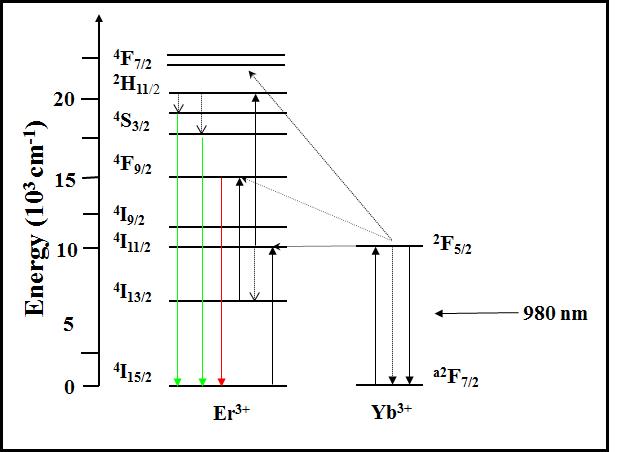
Upconversion nanocrystals (UCNCs) represent a new class of nonlinear optical materials that can convert low energy radiation into higher energy radiation. Upconversion holds the promise of increasing the power conversion efficiency of solar cells by limiting sub-band gap losses, especially for large band gap solar cells. In this project, we synthesize UCNCs and utilize them to potentially yield high efficiency hybrid solar cells by the incorporating of UCNCs that expand the absorption spectrum to near infrared range.
Representative Publications:
1. D. Vennerberg and Z. Lin, "Upconversion nanocrystals: synthesis, properties, assembly and applications”, Sci. Adv. Mater., 3, 26 (2011).
2. W. Liao, D. Zheng, J. Tian, and Z. Lin, "Dual-functional semiconductor-decorated upconversion hollow spheres for high efficiency dye-sensitized solar cells”, Journal of Materials Chemistry A. 3, 23360 (2015).
![]() Plasmonic Nanostructures
Plasmonic Nanostructures
Representative Publications:
1. B. Li, B. Jiang, H. Tang, and Z. Lin, "Unconventional Seed-Mediated Growth of Ultrathin Au Nanowires in Aqueous Solution”, Chemical Science. 6, 6349 (2015).
![]() Plasmonic/Magnetic Nanocrystals
Plasmonic/Magnetic Nanocrystals
Representative Publications:
1. D. Yang, X. Pang, Y. He, Y. Wang, G. Chen, W. Wang, and Z. Lin, "Precisely Size-Tunable Magnetic/Plasmonic Core/Shell Nanoparticles with Controlled Optical Properties”, Angewandte Chemie International Edition . 127, 12259 (2015).
![]() Ferroelectric/Magnetic Nanocrystals
Ferroelectric/Magnetic Nanocrystals
Description coming soon












